Malcolm Reid had heard the story many, many basketball moons ago.
Last week, the head coach of the Vernon Panthers’ senior boys basketball team recounted it to me, and just like the day he first heard it from a man named Dick Abbott, it almost sounded like a fable.
Earlier this month, Abbott — the father-in-law of Reid’s twin brother John — passed away at the age of 85, and as I studied the obituary of a dedicated family man, I couldn’t help but read and then re-read its additional details, all about a high school basketball career that Abbott enjoyed in New Westminster in the early-1950s as part of the record-setting threepeat champs at Duke of Connaught High under the legendary Ken ‘Hooker’ Wright.
The story that Abbott – a two-time B.C. tournament all-star – originally told Reid?
It went something like this: In the winter of 1952, a touring California boys high school all-star basketball team had embarked on an extended tour through the province of B.C., and although a complete unknown at the time, one member of that barnstorming group of selects was quite literally on the verge of unearthing the unique talents that would soon make him the most decorated, and in the eyes of many, the greatest player in the history of basketball.
We are, of course, speaking of the legendary Bill Russell, who just five years after facing Duke of Connaught and a host of other teams during his schoolboy tour through our province, had morphed into the 6-foot-10 lynchpin of a Boston Celtics’ dynasty which would win the first of its 11 NBA titles in 13 seasons.
“When I first met Dick years ago he told me some of this story of Bill Russell and I was amazed,” said Reid of Abbott who played in the game, “because I believe that most people in B.C. know nothing about it.”
In researching this story, that much proved to be a near-certainty.
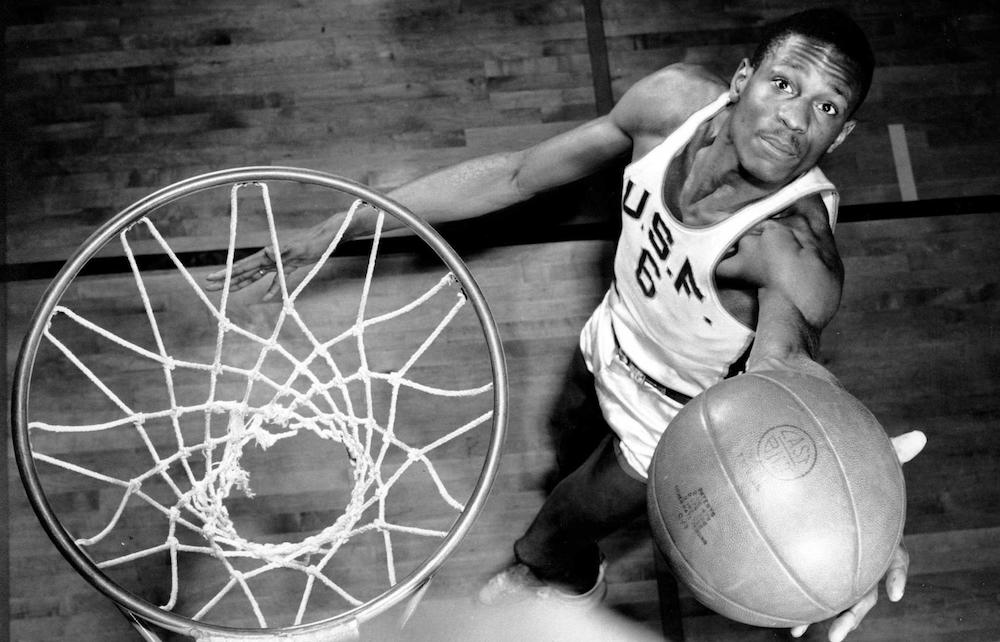
Over the past two weekends, we’ve shared some landmark basketball moments in our province’s basketball history.
First, the 1990 UNLV game at B.C. Place Stadium which 30 years ago helped set the stage for Vancouver’s brief era as an NBA city, and then last week re-living the 1958 NBA All-Star tour which touched down at UBC complete with 15 future Naismith Basketball Hall of Famers, including a then-24-year old Russell.
Today, to mark the 25th year anniversary of the Grizzlies first tip-off in Vancouver, we turn the clock back almost 63 years to a time when fittingly, there was no such thing as a shot clock… or a three-point line for that matter.
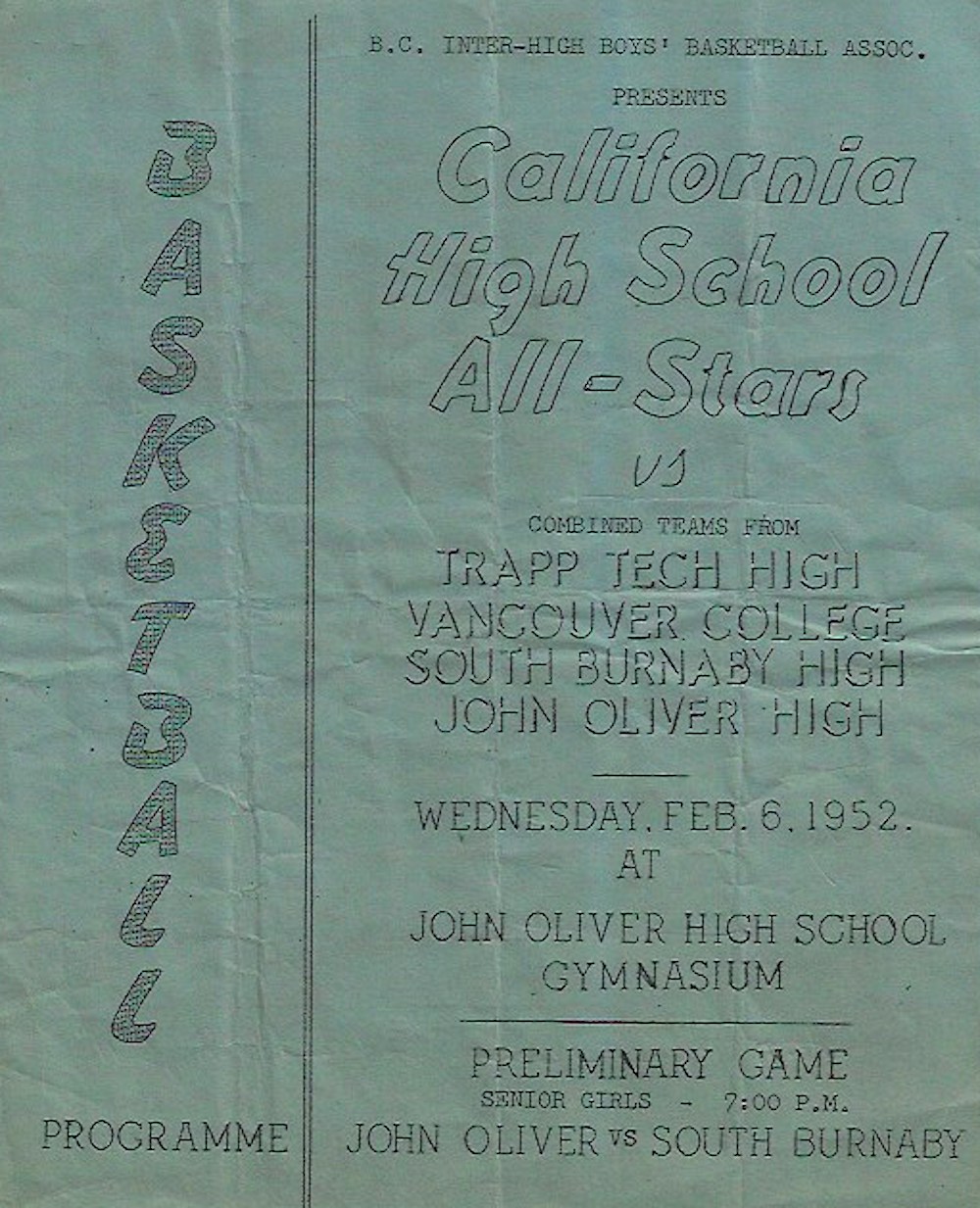
If you’ve got even trace amounts of a basketball historian’s DNA running through your veins, then you know that Bill Russell, now 86, is known today among other things as the father of modern-day NBA defence.
And that simple fact alone is what made the 1952 California High School All-Star tour so substantial.
Every great player can pinpoint the time in their career when both the mental and the physical aspects of their sport meshed to produce what would become their own unique lifelong identity.
For Bill Russell, that time came in 1952, right here in B.C. as he rode a Greyhound bus with his teammates through New Westminster, Vancouver, Victoria, Nanaimo, Penticton and Trail
A week shy of his 18th birthday when the visiting All-Stars played three games in two days against the Vancouver All-Stars, Duke of Connaught and the UBC Thunderbirds junior varsity back on Feb. 6-7 of that year, Bill Russell was listed on a hand-typed roster as 6-foot-7 Billy Russell or McClymonds High School in Oakland.
Yet contrary to what you think he might have represented at that very time in terms of being a force of nature on the hardwood, he was as yet completely unformed as it related to an on-court identity.
In his 1979 book ‘Second Wind: The Memoirs of an Opinionated Man’, Russell had described himself to that point in his basketball career as “…an easily forgettable high school player.”
Yet after learning that he had been selected to take part in the B.C. tour because he happened to be his school’s only ‘academic splitter’, a term reserved for those students whose school year ended in January, he headed to his local bus station and jumped aboard a non-chartered Greyhound for all points north. Russell added that the academic designation prevented many of the state’s top players from being able to take part on that tour.
“I was happier than if I’d found a thousand dollars under my pillow,” Russell wrote in Second Wind upon learning he had been selected. “Getting to go on that tour was luck. What would happen along the way was magic.”
A SUPERSTAR DISCOVERS HIS IDENTITY IN B.C.
Who’s the greatest basketball player of all time?
As Malcolm Reid and I discuss the modern template of shot-blocking defence pioneered by Russell, the former Vancouver College Fighting Irish (Class of ’88) guard reflects on some of the more spirited debates he has enjoyed recently with friends.
“With the whole ‘Michael Jordan vs. LeBron James-who is better’ argument, it’s evolved to the Mt. Rushmore conversation,” Reid tells me. “That is Bill Russell and Kareem (Abdul-Jabbar), and Jordan and LeBron. I am starting to hear more of a momentum for people saying ‘Bill Russell was better than all of them.’ I never saw Russell play, but the more I read, the more I’m convinced.”
Russell has co-authored several books on his career, and in all, he makes note of the awakening he experienced during what he calls ‘The Northwest Tour.’
Most precisely, he speaks to the freedom he was afforded to play his game on the tour by California coach Brick Swegle.
It allowed Russell to experiment, take chances and then ultimately to mesh his physical and cognitive skills on the court as the first player to purposefully leave his feet in pursuit of a blocked shot.
Ironically, although it became his signature, blocked shots were not kept as an official statistic until after his retirement from the game.
“On the Northwest Tour we were playing for fun,” continued Russell in Second Wind. “An acrobatic block might even draw an ‘ooh’ or an ‘ahh’ or even a hand-shake from your teammates.”
Then, in more revealing fashion in the book, he added: “I blocked so many shots after a couple of weeks on tour that my teammates began referring to them as ‘Russell moves’ which pleased me. They were acknowledging that I had a trademark they admired, and this was the first sign that my basketball personality would be built around defence.”
If you think about that for a second, it’s deeply telling.
The light-bulb moment in the mind of the greatest defensive player in the game’s history happened right here in our province, almost 70 years ago.
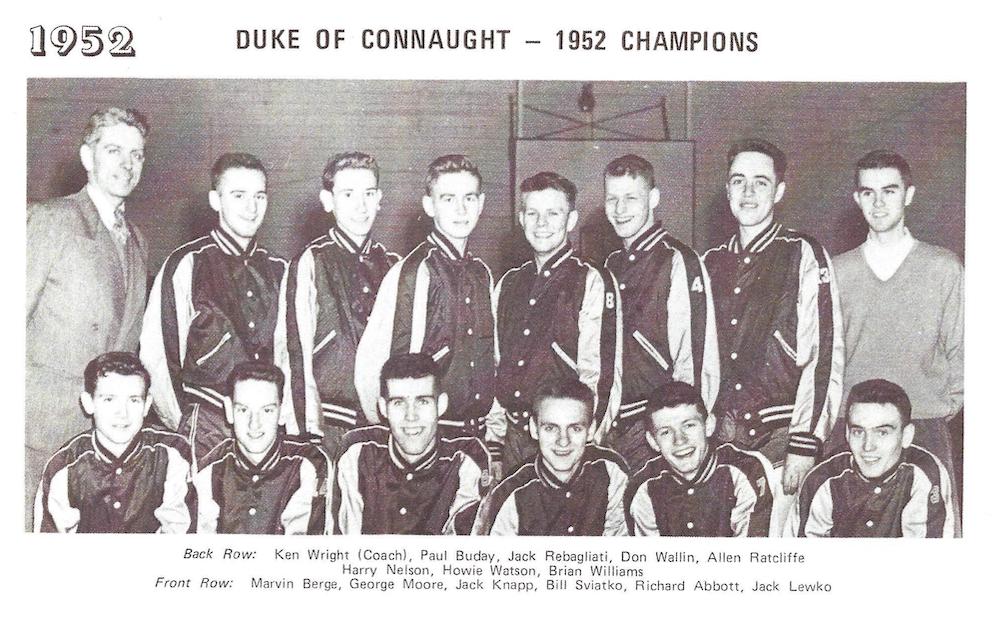
TAKING THE TIME MACHINE BACK TO 1952
There is a passion for the game of basketball that you can still hear in the voice of Paul Buday.
So much so, in fact, that it’s easy to imagine the former 5-foot-8 guard pouring home the 11 points he scored all those years ago at the New Westminster Junior High Gym when his Duke of Connaught team fell 102-43 to the California All-Stars.
“They scored a 102 points in a 32-minute game? Try to put the score down low,” said the classy Buday, now 87, with a jovial tone, rightfully proud of what his defending B.C. champions were nonetheless able to accomplish that day.
“Their coach told our coach, Ken Wright, that we were the best high school team they had played on the tour,” recalls Buday, who the next season would go on to start as a pure freshman at Western Washington after turning down an offer from the University of Oregon’s Fighting Ducks. “And from I believe they had also played in Alberta.”
Russell was impressive that night, no question, sharing the team-high with 17 points with teammate Bill Treu, a guard from Los Angeles who would later play at Brigham Young.
Wrote The Columbian Newspaper in its account of the game: “Centre Billy Russell just stood under the Connaught basketball, ladling them in.”
Yet Duke of Connaught’s players, while fully appreciative of the skill level they were facing from the opposition, were not a starry-eyed lot.
“We didn’t know who these kids were, they were just 12 more guys trying to put the ball through the hoop,” said Buday, whose team that night was led by the 14 points of Jack Lewko. “It is hard to remember that far back but we all knew that was the best team we had ever played. Their front line was big, and I remember they really controlled the boards on offence and defence.”
In fact although no one on the Duke of Connaught team doubted Russell’s talent that night, they didn’t actually realize who they had faced until years later.
“We didn’t know anything about Bill Russell at the time because he was just another Grade 12 student,” says Buday. “But then years down the road when he ended up playing for the Celtics, all of a sudden it started to hit home that ‘Hey, that sounds like the guy we played against in ’51-52.”
Buday did note that Connaught head coach Ken ‘Hooker’ Wright, one of the true basketball pioneers in B.C., and the man who led the program to a record three-straight provincial championships (1951-53), was an innovator in the game, encouraging a style of play that the Dukes discovered was in a lot of ways similar to the one the California visitors employed.
“Ken Wright gave us a free-flow game to play up and down the floor,” said Buday. “When we played against teams from Blaine and Bellingham, they would all come down the floor and set up a play. We would just get the ball, move down the floor and shoot it after two or three passes.”
That description of game flow in the early 1950s in B.C. might not seem revolutionary, yet if you take Russell’s account of the game the California All-Stars had played the day before at Vancouver’s John Oliver Secondary gymnasium against a combined team of all-stars from New Westminster’s Trapp Tech, Vancouver College, John Oliver and the then-called South Burnaby, you quickly understand that one the modern-day game’s most elemental staples had yet to gain widespread acceptance. And we’re talking about the jump shot.
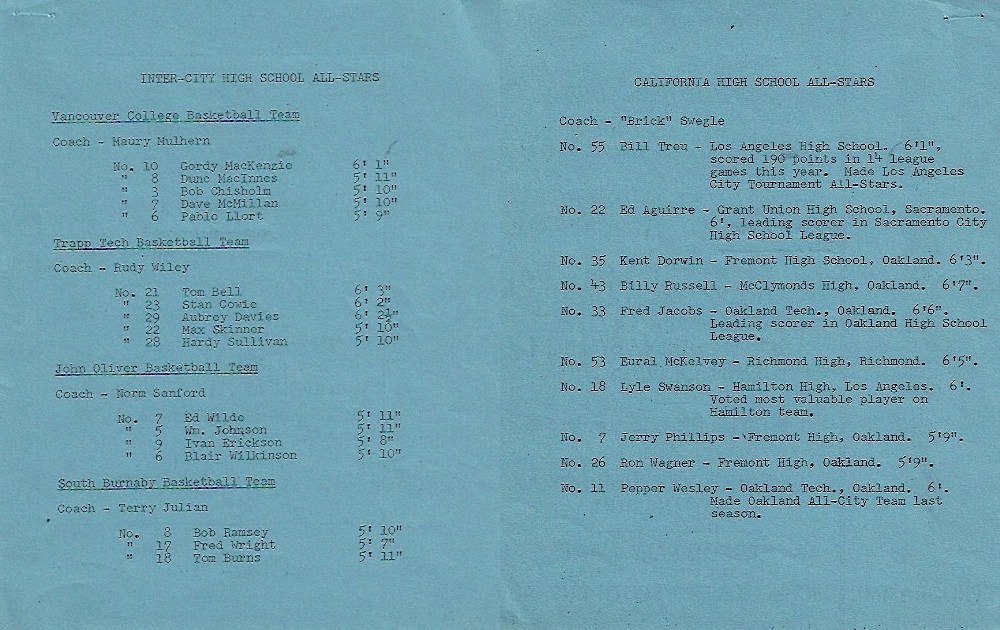
In Second Wind, Russell gives an extraordinarily in-depth description of that game, and although he doesn’t name the opposition, the score he references jibes with the game report from the next day’s edition of The Vancouver Sun.
“In one game the opposing coach got cocky when he saw us open up with jump shots,” Russell wrote. “‘Let ‘em have that shot’ he yelled at his players. He shared the established view that the jump shot could not work because it was performed off balance, and his players were under orders not to jump on defence. So we shot short jump shots all day while our opponents just stood there. We won 144-41.”
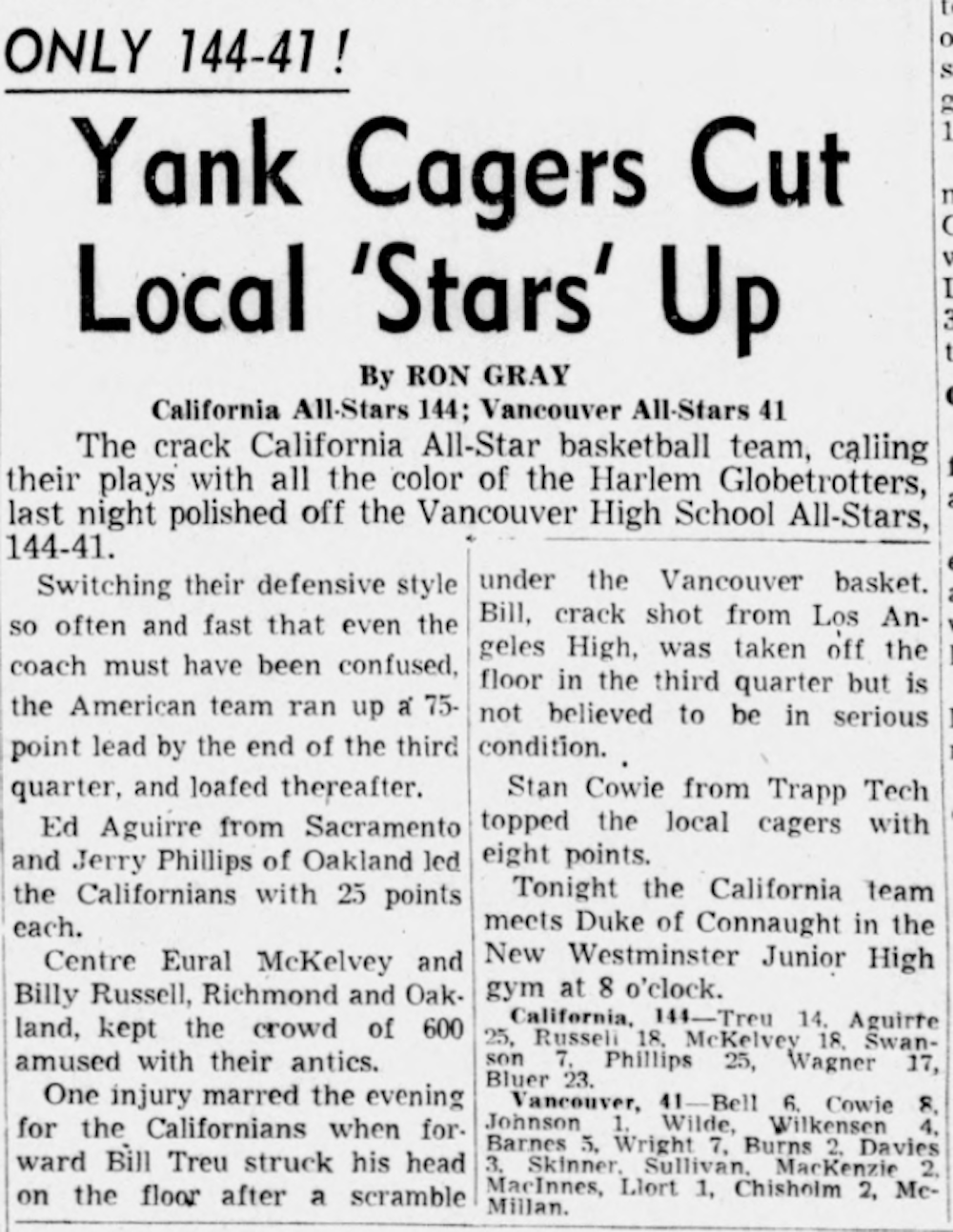
The Sun headline read: ‘Only 144-41! Yank Cagers Cut Local ‘Stars’ Up’.
Again, we’re talking about a 32 minute game.
The following afternoon, before they faced Duke of Connaught, the California team had played at a very new UBC War Memorial Gymnasium, and it took a shot by Stanford-bound guard Ron Wagner in the final minute of play to give the Californians a narrow 45-44 win. Russell’s point total was not listed, but teammate Eural McKelvey led the winners with 17 points.
UBC was led by the 11 points of Phil Barter and the 10 of John McLeod.
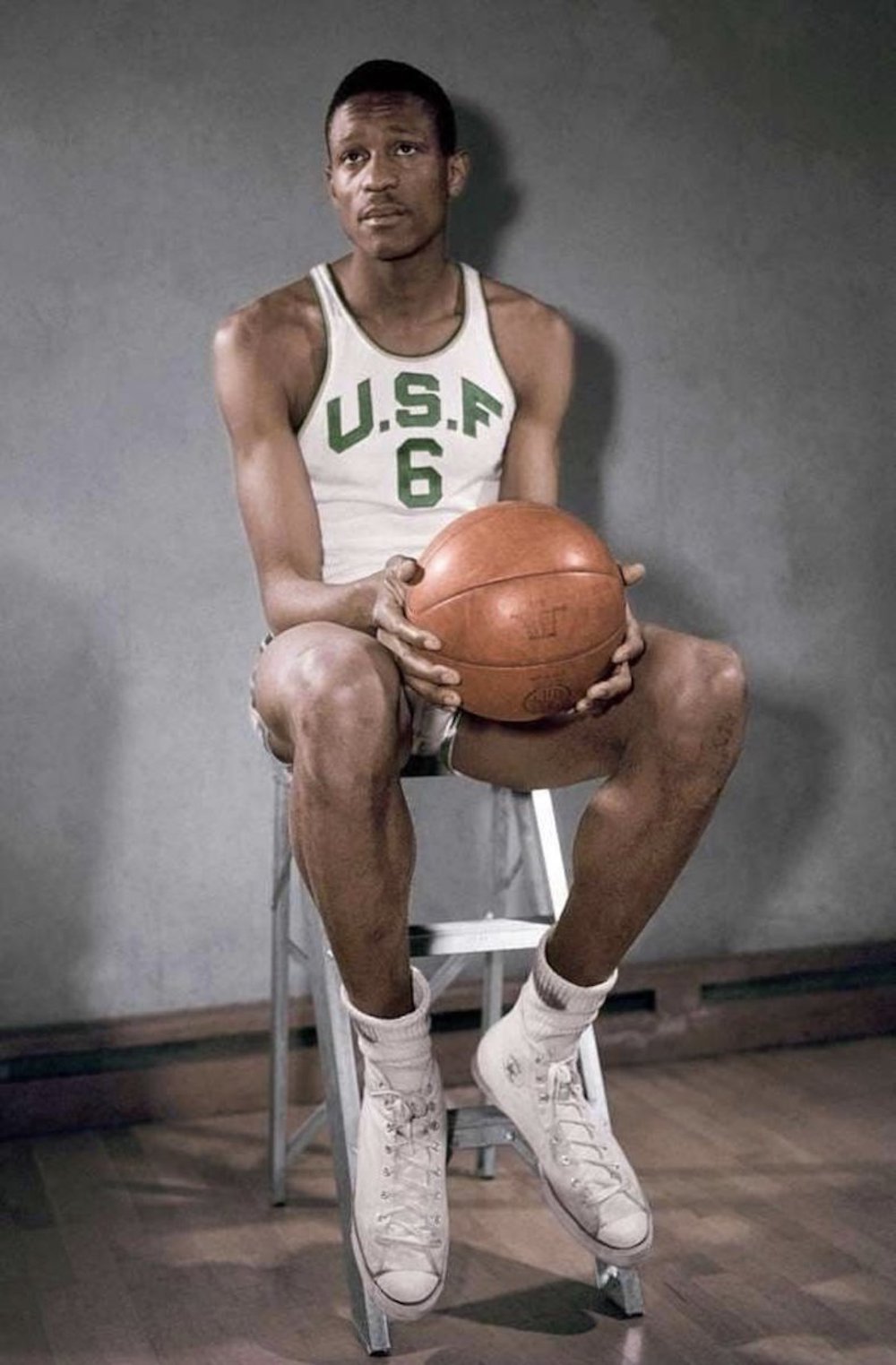
WHAT THE GAME WILL ALWAYS MEAN
Phyllis Nyhaug, nee Hanson, remembers all of the excitement at Duke of Connaught in of February of 1952, in the days leading up to the California All-Stars gam.
“It was quite an exciting day and evening,” remembers Nyhaug, who in later years would later marry Ernie Nyhaug, the UBC Thunderbird who had played Connaught’s 1951 B.C. title team.
About 600 fans attended the game that evening at the New Westminster junior high gym, and as was the custom of the day, a post-game gathering/reception for both teams had been planned.
Phyllis Nyhaug, these days 85 but back then just 17, had originally volunteered her home as the host location, “but when I told my dad how tall Bill Russell was, he thought that our house might be too small.”
Instead, the honours to host both teams went to a friend of Nyhaug’s.
“It was at a house in Sapperton, and the rumpus room was not much,” recalls Nyhaug. “It was not very tall, and (Russell) had to bend like mad to get in.”
“What else does Nyhaug remember about the reception?
“(Russell) was shy, but he talked to everybody,” Nyhaug continued. “But we didn’t drink like they do today. We had pop. I don’t think we even had coffee.”
She does have one regret.
“We were just kids,” she adds. “I didn’t ask him for an autograph. Now that my kids are grown up and retired they said ‘You should have gotten his autograph.’”
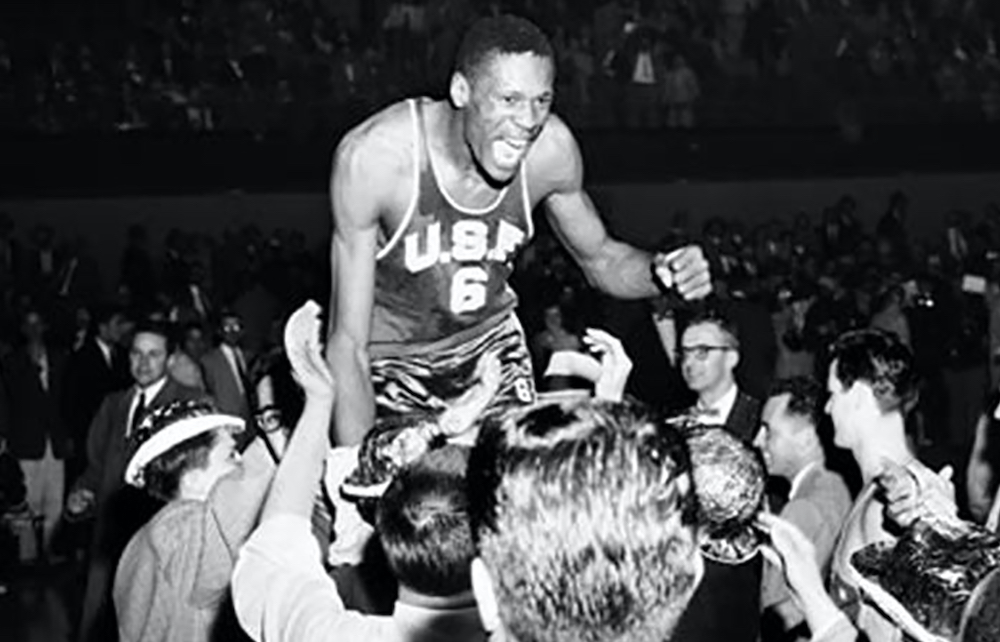
Upon his return to Oakland, Russell was surprised to discover that the University of San Francisco had been calling after him, having had seen him play one game in which he had scored, to that point, a career-high 14 points.
The rest, as they say, is history.
Russell would eventually lead the NCAA Dons to back-to-back national championships in 1955 and ’56, and after some draft day manoeuvring, was delivered to the Celtics by Red Auerbach to launch a dynasty during which time he would win more championships than any player in NBA history.
He developed a habit of studying both his moves and the moves of others through a “mental camera” and that cognitive process, the one he used to help him play the game at a level above his competition his entire career, was developed as he rode the bus on that so-called Northwest Tour.
“As the tour went further north into Canada,” he continued in Second Wind, “the roads stretched into hundreds of miles between stops, which sometimes gave me 12 straight hours of mental basketball on the Greyhound. The tour was one of those rare times when fantasy and reality are so close together, they feed off each other.”
Looking back to almost 69 years ago, the natural reaction is to fantasize that Bill Russell strode off a Greyhound Bus in the Lower Mainland and simply eat up his competition for breakfast, lunch and dinner, a fully-formed prodigy already well able to summon his substantial basketball powers.
The reality, however, is much different.
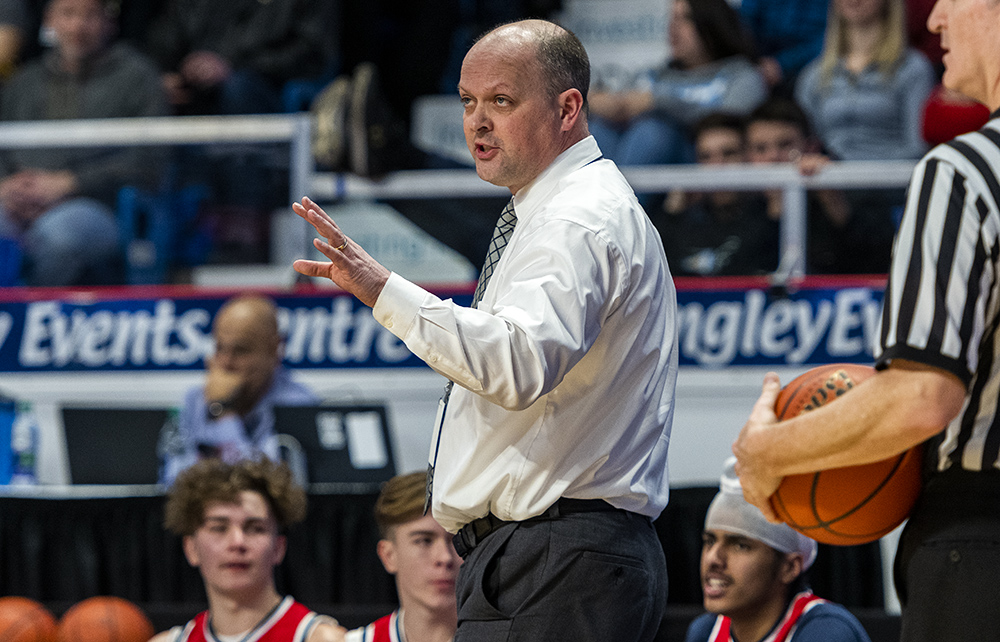
Basketball gave him a profile, an identity and of course massive fame, yet it never shielded him from the racism he would encounter throughout his life, as he wrote with both grit and eloquence this past summer in a story for SLAM Magazine’s Social Justice issue entitled ‘Bill Russell’s Lifelong Fight Against Racism’.
“In many ways, I owe my happiness to the love my parents gave me,” he wrote in SLAM. “Their love gave me the confidence to simply be me: a proud Black man, fair, and I believe, dignified.
A mountain of a man, both literally and figuratively.
A man who changed basketball forever, and who continues to fight for an end to systematic racism.
Each of us, in all of our varied ways, has at one time or another sought that which truly defines our sense of self.
Its discovery is pure empowerment.
“My understanding is that he was a kid who never thought he could achieve, but then he realized ‘I am good at something,’” Malcom Reid says of what he has learned about Russell.
“You know, that is what basketball still does today for so many kids, and that is what we are missing through the pandemic,” he adds. “Kids aren’t putting on their team’s uniform right now, and this is a long-standing impact of the pandemic. It’s the perfect comment on why we need to rejuvenate this thing, once we’re able to, as fast as we can.”
Thanks, Malcolm.
Thanks for telling me a basketball story that you’d been told so many, many basketball moons ago by a man named Dick Abbott.
To myself and so many others, Bill Russell has always seemed larger than life.
And as someone who cherishes the basketball history of our province, it should be duly noted that the greatest player in the history our the sport (let the debate rage on!) discovered his identity in the game, almost 69 years ago, at the age of 17-going-on-18, right here in B.C.
That’s the ‘sugar-on-top’ part of a story I am always going to be proud to tell.
If you’re reading this story or viewing these photos on any website other than one belonging to a university athletic department, it has been taken without appropriate permission. In these challenging times, true journalism will survive only through your dedicated support and loyalty. VarsityLetters.ca and all of its exclusive content has been created to serve B.C.’s high school and university sports community with hard work, integrity and respect. Feel free to drop us a line any time at howardtsumura@gmail.com.

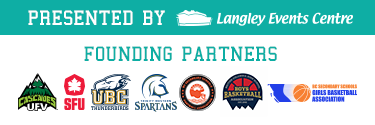
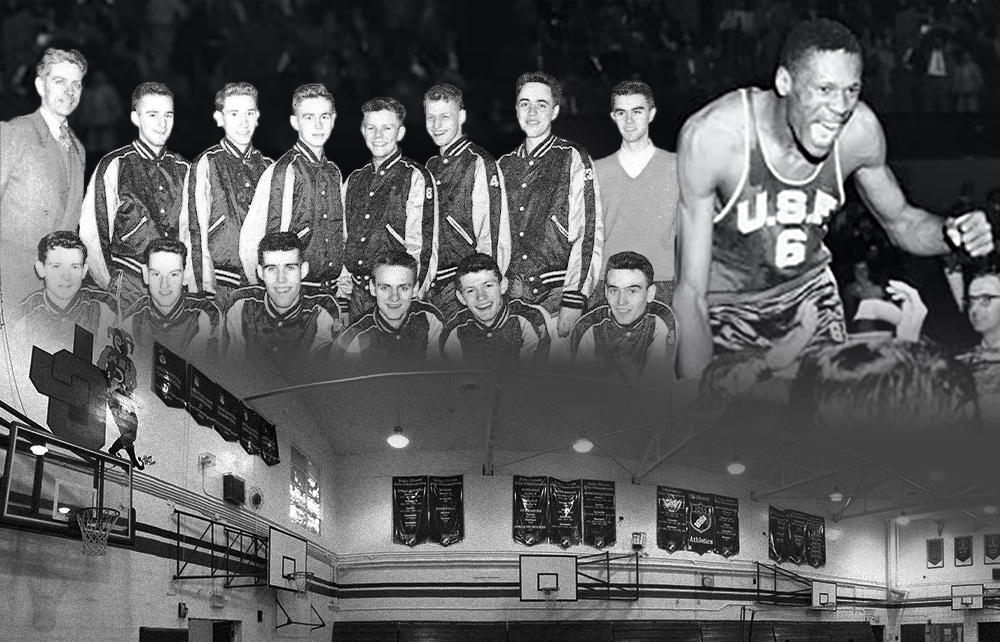
Thanks to Malcolm Reid, Ken Winslade and others for their part in this story and of course to Howard Tsumura for just an excellent job of research, interviewing and writing the story.
I first heard of this tour many years ago from Ed Pedersen, the longtime North Vancouver High and Handsworth coach, who had played for Victoria High against Bill Russell during that tour.
One other interesting note is that Eural McKelvey, one of the other star California players, later played for the Harlem Clowns who used to play in BC during the 1950s and 1960s.
Here’s part of a story I found on the Internet:
“In the mid 1950s, [Greg} McKelvey’s father [Eural] was drafted by the Milwaukee/St. Louis Hawks, starting as a small forward alongside Bob Pettit Jr., the first recipient of the NBA’s Most Valuable Player Award. However, McKelvey said that at the end of the preseason, his father was told he had to be cut from the team because people weren’t ‘ready for a black ball player.’
“After being cut from the Hawks, Eural was picked up by the Harlem Globetrotters and played with them for about five years. He was then drafted into the U.S. Army and when he returned, he joined the Harlem Clowns as a player and coach, which he did for about 25 years. McKelvey’s two brothers, who were both avid basketball players at 6-foot-10 and 6-foot-8, currently own the Harlem Clowns team.
“In addition to basketball, [Greg] McKelvey’s father was also a skilled baseball player and was, at one point, drafted by the St. Louis Cardinals.”
“He was just a superior athlete to all of us,” McKelvey said of his dad. “We couldn’t compete with that. At least basketball got us all scholarships.”
We really do have some interesting basketball history in B.C.
Len Corben
Russell’s team also played in Alberni on that tour. Russell was billeted with Bob Pennington [deceased],one of the Alberni players. Bob’s mother was away for the weekend so Bill Russel was given her room in the Pennington apartment. Late at night Mrs Pennington came home unexpectantly and found Bill’s feet sticking out the end of her bed !!! Lots of screaming and yelling and eventually laughing. Bob had apparently did not tell his mom about taking a billett !
When I moved to Penticton in 1976I heard stories about Bill Russell having played here as part of the California team tour. Having known Ken Wright during my coaching career made this article very special.Thanks for bringing B.C. high school basketball memories alive for all us old timers
Gord McKay
Great story! Thank you from a former Pen-Hi (Penticton) and Revelstoke BB coach. An intriguing part of BC high school sport history.